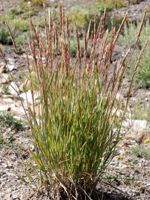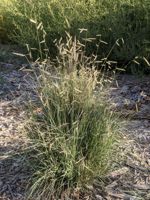Mon-Fri 9am - 5pm Mountain time
Slender Wheatgrass vs Blue Grama Grass
Elymus trachycaulus
Bouteloua gracilis
CUSTOM GROW
NOT AVAILABLE THIS SEASON - MIGHT RETURN
Slender Wheatgrass is a native perennial bunchgrass common across North America. It establishes quickly, making it effective for site recovery.
It produces upright seed heads that provide seasonal interest and seed for wildlife, and favoured for browsing by elk and sheep. Its seeds are eaten by birds and small mammals, and it provides cover for wildlife.
Slender Wheatgrass is among the first native grasses used for reclamation in western Canada and the U.S. It does exceptionally well in saline soils.
Blue Grama is a native perennial bunchgrass recognized for its blue-green blades and unique seed heads. They grow along one side of the stem and are often compared to eyelashes, eyebrows, or mosquito larvae, which inspired its common names, Eyelash Grass and Mosquito Grass. As the seed heads begin to dry in the fall, they curl, further enhancing the plant’s distinctive appearance. The seeds provide food for birds, and the grass serves as a host plant for certain species of skipper butterflies.
As a warm-season grass, Blue Grama has a slow start in spring and does not actively grow until soil temperatures rise. Its deep roots help with erosion control, and the grass is drought-tolerant once established, thriving even in poor or alkaline soils. It is well-suited for soil stabilization, naturalization, restoration projects, or as an ornamental accent in gardens and landscapes.

